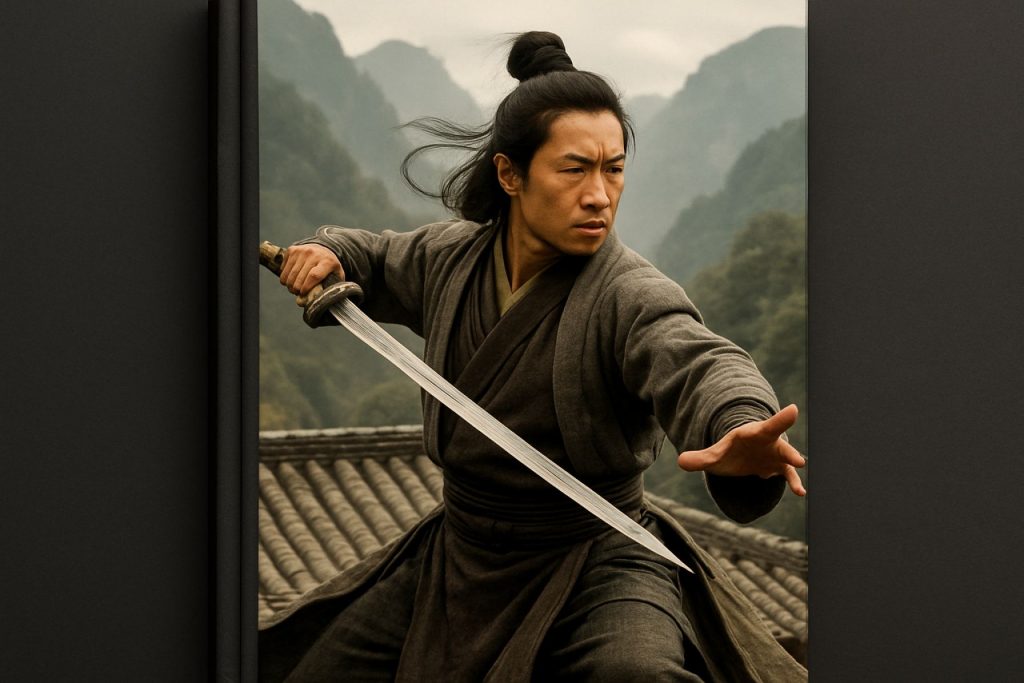
Wuxia Literature Explored: The Enduring Power, Cultural Impact, and Global Rise of Chinese Martial Arts Storytelling. Discover How Ancient Legends Shape Modern Imagination. (2025)
- Origins and Historical Evolution of Wuxia Literature
- Core Themes: Chivalry, Honor, and Martial Virtue
- Iconic Authors and Seminal Works in Wuxia
- Narrative Structures and Literary Techniques
- Wuxia’s Influence on Chinese Popular Culture
- Adaptations: Film, Television, and Digital Media
- Globalization: Wuxia’s International Reach and Reception
- Technology’s Role: Digital Publishing and Online Communities
- Market Trends and Public Interest Forecast (2024–2030)
- Future Outlook: Innovations and the Next Generation of Wuxia
- Sources & References
Origins and Historical Evolution of Wuxia Literature
Wuxia literature, a distinctive genre of Chinese fiction, traces its origins to ancient Chinese storytelling traditions that celebrate martial heroes, chivalry, and the pursuit of justice. The term “wuxia” (武俠) combines “wu” (martial) and “xia” (chivalrous hero), encapsulating the genre’s focus on martial prowess and moral integrity. Its roots can be found in the oral tales and written records of the Warring States period (475–221 BCE), where wandering swordsmen and righteous knights-errant, known as “xia,” were celebrated in folklore and early historical texts such as the “Records of the Grand Historian” by Sima Qian.
During the Han dynasty (206 BCE–220 CE), the figure of the xia became further entrenched in Chinese culture, appearing in both historical accounts and popular legends. The Tang (618–907) and Song (960–1279) dynasties saw the proliferation of “chuanqi” (tales of the marvelous) and “huaben” (vernacular short stories), which often featured martial heroes and fantastical adventures. These stories laid the groundwork for the narrative conventions and archetypes that would define wuxia literature.
The Ming (1368–1644) and Qing (1644–1912) dynasties marked a significant evolution in the genre, with the emergence of full-length novels such as “Water Margin” (Shuihu Zhuan) and “The Seven Heroes and Five Gallants.” These works integrated complex plots, vivid characterizations, and a codified set of martial arts techniques, further shaping the wuxia tradition. The genre’s popularity continued to grow, with serialized stories appearing in newspapers and magazines during the late Qing and Republican eras, making wuxia accessible to a broader audience.
The 20th century witnessed a renaissance in wuxia literature, particularly in Hong Kong and Taiwan, where authors like Jin Yong (Louis Cha) and Gu Long revolutionized the genre. Their works, characterized by intricate plots, philosophical depth, and innovative martial arts systems, brought wuxia to new heights of literary and cultural significance. The genre’s influence extended beyond literature, inspiring films, television dramas, comics, and video games, and contributing to the global recognition of Chinese popular culture.
Today, wuxia literature remains a vital part of Chinese literary heritage, reflecting evolving social values and artistic trends. Its enduring appeal lies in its ability to blend historical settings, moral dilemmas, and imaginative storytelling, ensuring its continued relevance in contemporary culture. Institutions such as the China Internet Information Center and the China Culture portal provide resources and insights into the ongoing development and significance of wuxia literature in the modern era.
Core Themes: Chivalry, Honor, and Martial Virtue
Wuxia literature, a cornerstone of Chinese popular culture, is distinguished by its exploration of core themes such as chivalry (xiá), honor, and martial virtue (wǔdé). These themes are not merely narrative devices but serve as the ethical and philosophical backbone of the genre, shaping both character motivations and the moral universe in which their stories unfold.
Chivalry in wuxia, often referred to as “xiayi” (侠义), is a complex ideal that transcends simple heroism. It embodies a commitment to justice, altruism, and the protection of the vulnerable, even at great personal risk. Wuxia protagonists, known as “xia” (侠), are typically martial artists who operate outside the boundaries of conventional authority, guided by their own moral compass. Their actions are driven by a sense of duty to right wrongs and defend the oppressed, reflecting a deep-rooted cultural valorization of individual agency in the pursuit of social justice.
Honor is another central theme, intricately linked to personal integrity and reputation. In the world of wuxia, a character’s honor is often tested through trials that demand sacrifice, loyalty, and unwavering adherence to promises. The concept of “face” (miànzi) and the importance of keeping one’s word are recurrent motifs, with breaches of honor leading to social ostracism or tragic consequences. This emphasis on honor serves to reinforce communal values and the social fabric of the martial world, or “jianghu” (江湖), a semi-mythical realm where martial artists interact according to their own codes.
Martial virtue, or “wude” (武德), encapsulates the ethical use of martial skills. It is not enough for a wuxia hero to possess physical prowess; true greatness is measured by the restraint, humility, and compassion with which such power is wielded. The cultivation of martial virtue is often depicted as a lifelong journey, paralleling the Confucian ideal of self-cultivation. This theme underscores the belief that martial arts are not merely techniques for combat but vehicles for moral and spiritual development.
These core themes are deeply embedded in the cultural and philosophical traditions of China, drawing from Confucian, Daoist, and Buddhist thought. They continue to resonate in contemporary adaptations of wuxia, influencing literature, film, and television across the Chinese-speaking world and beyond. The enduring appeal of chivalry, honor, and martial virtue in wuxia literature reflects a universal longing for justice, integrity, and the transformative power of individual action within society.
Iconic Authors and Seminal Works in Wuxia
Wuxia literature, a cornerstone of Chinese popular culture, has been shaped by a lineage of iconic authors whose works have defined and expanded the genre. Among the most influential is Jin Yong (Louis Cha), whose novels such as The Legend of the Condor Heroes and The Smiling, Proud Wanderer are considered masterpieces. Jin Yong’s intricate plots, memorable characters, and philosophical depth have made his works central to the modern wuxia canon. His stories, serialized from the 1950s to the 1970s, have been adapted into countless films, television series, and comics, cementing his legacy as the preeminent wuxia novelist of the 20th century. Jin Yong’s influence extends beyond literature, with his works studied in academic settings and recognized for their cultural significance by institutions such as The Chinese University of Hong Kong, which houses the Jin Yong Gallery.
Another towering figure is Gu Long, whose distinctive style brought a new sensibility to wuxia fiction. Gu Long’s narratives, including Sentimental Swordsman, Ruthless Sword and The Eleventh Son, are known for their terse prose, psychological complexity, and existential undertones. His approach diverged from traditional chivalric themes, focusing instead on flawed heroes and ambiguous morality. Gu Long’s innovations have inspired generations of writers and filmmakers, and his works remain widely read and adapted.
Liang Yusheng, often credited with pioneering the modern wuxia novel, played a crucial role in revitalizing the genre in the postwar era. His debut work, Longhu Dou Jinghua (The Dragon and Tiger Fight for Glory), serialized in the 1950s, set the template for serialized wuxia storytelling. Liang’s novels are noted for their historical settings and integration of real events, blending fact and fiction to create immersive narratives. His contributions laid the groundwork for the genre’s golden age and influenced both Jin Yong and Gu Long.
Other notable authors include Wen Rui’an, whose prolific output and inventive plots have kept wuxia vibrant into the 21st century, and Huang Yi, who introduced elements of science fiction and time travel, expanding the genre’s boundaries. Collectively, these authors have produced a body of work that not only entertains but also explores themes of honor, loyalty, and the human condition, ensuring wuxia’s enduring appeal. Their legacies are preserved and promoted by cultural organizations and academic institutions across the Chinese-speaking world, reflecting the genre’s significance in both literary and popular contexts.
Narrative Structures and Literary Techniques
Wuxia literature, a cornerstone of Chinese popular fiction, is distinguished by its unique narrative structures and sophisticated literary techniques. At its core, wuxia—literally “martial heroes”—weaves tales of chivalry, martial arts, and personal transformation, often set against the backdrop of a semi-mythical “jianghu” (rivers and lakes) world. The narrative structure of wuxia is typically episodic, following the protagonist’s journey through a series of trials, alliances, and confrontations. This structure allows for the exploration of themes such as honor, loyalty, and the tension between individual desires and societal expectations.
A hallmark of wuxia narrative is the use of the “hero’s journey” archetype, where the central character, often an orphan or outsider, undergoes rigorous training, faces moral dilemmas, and ultimately achieves mastery in both martial arts and personal virtue. This progression is frequently punctuated by encounters with mentors, rivals, and secret societies, each contributing to the protagonist’s growth. The episodic nature of these stories enables authors to introduce a wide array of characters and subplots, enriching the tapestry of the wuxia world.
Literary techniques in wuxia are equally distinctive. Authors employ vivid, action-oriented prose to depict martial arts sequences, often using metaphor and hyperbole to convey the speed, power, and elegance of combat. Descriptions of “qigong” (internal energy) and fantastical techniques blur the line between reality and legend, imbuing the narrative with a sense of wonder. Dialogue is another crucial tool, with characters engaging in philosophical debates about justice, fate, and the nature of heroism—reflecting the influence of Confucian, Daoist, and Buddhist thought.
Wuxia writers also make extensive use of foreshadowing and parallelism, crafting intricate plots that reward attentive readers. The interplay between fate and free will is a recurring motif, often embodied in the protagonist’s struggle to reconcile personal ambition with the greater good. Symbolism is prevalent, with weapons, landscapes, and even martial arts styles serving as extensions of character and theme.
In recent years, the narrative structures and literary techniques of wuxia have influenced other genres and media, including film, television, and video games, contributing to the global spread of Chinese popular culture. Organizations such as the China Culture Administration and the China Internet Information Center have highlighted the enduring appeal and cultural significance of wuxia literature, underscoring its role in shaping both traditional and contemporary storytelling.
Wuxia’s Influence on Chinese Popular Culture
Wuxia literature, a genre centered on martial heroes and chivalric codes, has profoundly shaped Chinese popular culture, especially throughout the 20th and 21st centuries. Rooted in ancient Chinese folklore and historical narratives, wuxia stories typically follow wandering swordsmen, martial artists, and their adventures in a semi-mythical “jianghu” (rivers and lakes) world. The genre’s enduring popularity is evident in its pervasive influence on literature, film, television, comics, and even video games in China and across East Asia.
The modern wuxia literary tradition was largely defined by writers such as Jin Yong (Louis Cha) and Gu Long, whose serialized novels in the mid-20th century revitalized the genre. Jin Yong’s works, including “The Legend of the Condor Heroes” and “The Smiling, Proud Wanderer,” have sold hundreds of millions of copies and are considered cultural touchstones. These stories not only entertained but also reflected and shaped ideals of loyalty, honor, and resistance against oppression, resonating with readers during times of social change.
Wuxia’s influence extends far beyond the printed page. Adaptations of classic wuxia novels have dominated Chinese television and cinema for decades, with iconic films such as “Crouching Tiger, Hidden Dragon” and “Hero” introducing wuxia aesthetics and philosophy to global audiences. The genre’s visual and narrative motifs—such as gravity-defying swordplay, intricate martial arts choreography, and themes of personal sacrifice—have become hallmarks of Chinese popular media. The China Film Administration, the official body overseeing film production and distribution, has recognized wuxia cinema as a significant contributor to the international reputation of Chinese film.
In addition, wuxia’s narrative structures and archetypes have influenced contemporary Chinese comics (manhua), animation, and online literature. The rise of web novels and digital publishing platforms has led to a new generation of wuxia-inspired works, blending traditional motifs with modern storytelling techniques. This digital renaissance has further cemented wuxia’s role in shaping the tastes and imaginations of younger audiences.
Wuxia literature’s impact is also evident in the way it has helped define Chinese cultural identity, both domestically and in the diaspora. The genre’s emphasis on moral integrity, self-cultivation, and the tension between individual freedom and social responsibility continues to inform popular discourse and artistic expression. As China’s cultural industries expand globally, wuxia remains a vital and dynamic force in the evolution of Chinese popular culture, celebrated by institutions such as the Ministry of Culture and Tourism of the People’s Republic of China for its role in promoting national heritage and creative innovation.
Adaptations: Film, Television, and Digital Media
Wuxia literature, with its rich tapestry of martial arts, chivalry, and fantastical adventures, has long served as a wellspring for adaptations across film, television, and digital media. The genre’s visual and narrative dynamism makes it particularly suited for screen reinterpretation, and its influence has extended far beyond its literary origins, shaping popular culture throughout East Asia and globally.
The earliest wuxia film adaptations date back to the silent era of Chinese cinema in the 1920s and 1930s, with studios in Shanghai pioneering the genre’s cinematic language. Over the decades, Hong Kong became a central hub for wuxia filmmaking, especially during the 1960s and 1970s, when studios such as Shaw Brothers and Golden Harvest produced iconic films that defined the genre’s visual style and choreography. These adaptations often drew directly from the works of celebrated wuxia novelists like Jin Yong (Louis Cha) and Gu Long, whose stories provided a narrative backbone for countless productions.
Television has also played a pivotal role in popularizing wuxia literature. Since the 1980s, serialized TV dramas based on classic novels have captivated audiences across China, Taiwan, and Hong Kong. These adaptations, often spanning dozens of episodes, allow for more faithful and nuanced explorations of the source material’s complex plots and character arcs. The enduring popularity of these series is evident in the frequent remakes and reinterpretations of beloved stories, reflecting both technological advancements and evolving audience tastes.
In the 21st century, digital media has further expanded the reach and form of wuxia adaptations. Streaming platforms and online video services have enabled the production of high-budget web series and films, often targeting younger, tech-savvy audiences. Interactive media, such as video games and webcomics, have also embraced wuxia themes, offering immersive experiences that blend traditional storytelling with modern technology. This digital evolution has facilitated the global dissemination of wuxia, introducing its unique blend of martial arts and moral philosophy to new audiences worldwide.
The international impact of wuxia adaptations is perhaps best exemplified by films like “Crouching Tiger, Hidden Dragon,” which garnered critical acclaim and commercial success across the globe. Such works have not only elevated the genre’s profile but have also inspired filmmakers and creators outside of China to explore similar themes and aesthetics. As the landscape of media continues to evolve in 2025, wuxia literature remains a vibrant source of inspiration, continually reinvented through film, television, and digital innovation.
Globalization: Wuxia’s International Reach and Reception
Wuxia literature, a genre rooted in Chinese martial arts, chivalry, and folklore, has experienced significant globalization over the past several decades. Traditionally, wuxia stories were confined to Chinese-speaking regions, with their earliest forms dating back to the Tang and Song dynasties. However, the late 20th and early 21st centuries have seen wuxia narratives transcend linguistic and cultural boundaries, gaining international recognition and readership.
The globalization of wuxia literature can be attributed to several key factors. First, the translation of seminal works by authors such as Jin Yong (Louis Cha) and Gu Long into English and other major languages has played a pivotal role. These translations have introduced global audiences to the genre’s unique blend of martial arts philosophy, moral dilemmas, and fantastical elements. Academic institutions and cultural organizations have also contributed by supporting research, translation, and dissemination of wuxia texts. For example, the United Nations Educational, Scientific and Cultural Organization (UNESCO) has recognized the importance of preserving and promoting intangible cultural heritage, which includes literary traditions like wuxia.
The international reach of wuxia has been further amplified by adaptations in film, television, and digital media. Iconic movies such as “Crouching Tiger, Hidden Dragon” and “Hero” have brought wuxia aesthetics and storytelling to global cinema, sparking interest in the original literary sources. Streaming platforms and online publishing have also enabled serialized wuxia novels to reach readers worldwide, often in real-time translations. This digital proliferation has fostered vibrant fan communities and scholarly engagement across continents.
Reception of wuxia literature outside China has been marked by both enthusiasm and adaptation. While some readers are drawn to the genre’s exoticism and action, others appreciate its exploration of universal themes such as honor, loyalty, and the struggle between good and evil. Academic circles in North America, Europe, and Southeast Asia have increasingly incorporated wuxia studies into comparative literature and cultural studies curricula, reflecting its growing legitimacy as a subject of global literary inquiry.
Despite these advances, challenges remain. Nuances of language, cultural context, and historical references can be difficult to convey in translation, sometimes leading to misinterpretation or oversimplification. Nonetheless, the ongoing efforts of translators, scholars, and cultural organizations continue to bridge these gaps, ensuring that wuxia literature remains a dynamic and influential force in the global literary landscape.
Technology’s Role: Digital Publishing and Online Communities
The digital revolution has profoundly transformed the landscape of Wuxia literature, particularly through the rise of digital publishing platforms and the proliferation of online communities. In the early 21st century, the migration from print to digital formats enabled Wuxia stories to reach a broader, more global audience. Major Chinese technology companies, such as Tencent and Alibaba Group, have played pivotal roles in this transformation by investing in online literature platforms and fostering ecosystems where Wuxia thrives.
Tencent’s China Literature division, for example, operates some of the largest online reading platforms, including Qidian, which hosts thousands of Wuxia and Xianxia novels. These platforms allow authors to serialize their works, interact directly with readers, and monetize their content through subscriptions, microtransactions, and rewards. This model has democratized the creation and dissemination of Wuxia literature, enabling new voices to emerge outside traditional publishing houses.
The digital environment has also fostered vibrant online communities centered around Wuxia. Forums, social media groups, and fan sites provide spaces for readers to discuss plotlines, share fan fiction, and recommend new works. These communities often transcend national boundaries, with international fans accessing translated Wuxia novels and participating in discussions. The collaborative nature of these platforms has led to the rapid evolution of the genre, as feedback loops between authors and readers encourage experimentation and innovation.
Moreover, the integration of artificial intelligence and big data analytics by companies like Tencent has enabled platforms to recommend personalized content, analyze reader preferences, and optimize the visibility of popular or emerging Wuxia works. This technological synergy not only enhances user engagement but also supports the commercial viability of Wuxia literature in the digital age.
In 2025, the role of technology in Wuxia literature continues to expand, with mobile reading apps, interactive storytelling formats, and even virtual reality experiences being explored. The convergence of digital publishing and online communities ensures that Wuxia remains a dynamic and accessible genre, continually adapting to new technological possibilities and the evolving tastes of a global readership.
Market Trends and Public Interest Forecast (2024–2030)
Between 2024 and 2030, the market for Wuxia literature is projected to experience both consolidation and expansion, driven by evolving reader demographics, digital transformation, and cross-media adaptations. Wuxia, a genre rooted in Chinese martial arts fiction, has traditionally enjoyed a robust following in East Asia, particularly in China, Taiwan, and Hong Kong. However, recent years have seen a notable increase in global interest, fueled by the international success of Wuxia-inspired films, television series, and web novels.
Digital platforms are playing a pivotal role in this growth. Major Chinese online literature portals, such as those operated by China Internet Information Center and China Central Television, have reported rising engagement with serialized Wuxia content, especially among younger readers. The proliferation of mobile reading apps and web-based publishing has lowered barriers to entry for both authors and readers, enabling a new generation of writers to reinterpret classic Wuxia themes for contemporary audiences. This digital shift is expected to continue, with forecasts indicating that online Wuxia literature will account for a significant share of the genre’s overall consumption by 2030.
Cross-media adaptations are another key trend. Wuxia stories are increasingly being adapted into television dramas, films, comics (manhua), and even video games, broadening their appeal and introducing the genre to new audiences worldwide. State-backed organizations such as the National Radio and Television Administration (NRTA) have supported the production and export of Wuxia-themed content, contributing to the genre’s international visibility. The success of Wuxia adaptations on global streaming platforms has further amplified this trend, with international viewers showing growing interest in the genre’s unique blend of martial arts, philosophy, and historical fantasy.
Looking ahead to 2030, public interest in Wuxia literature is expected to remain strong, with particular growth in Southeast Asia, North America, and Europe. The genre’s adaptability—its ability to blend traditional motifs with modern storytelling techniques—positions it well for continued relevance. Educational institutions and cultural organizations, including the Confucius Institute, are also promoting Wuxia literature as part of broader efforts to foster cross-cultural understanding and appreciation of Chinese literary heritage.
In summary, the Wuxia literature market is forecasted to benefit from digital innovation, cross-media synergy, and expanding international interest through 2030, ensuring its enduring presence in both domestic and global literary landscapes.
Future Outlook: Innovations and the Next Generation of Wuxia
The future of Wuxia literature in 2025 is poised at a dynamic intersection of tradition and innovation, as new generations of writers and readers engage with this storied genre. Wuxia, which translates to “martial heroes,” has long been a cornerstone of Chinese literary culture, blending historical settings, martial arts philosophy, and themes of chivalry. As digital technologies and global cultural exchanges accelerate, the genre is undergoing significant transformation.
One of the most notable innovations is the proliferation of digital publishing platforms, which have democratized access to Wuxia stories and enabled a surge in user-generated content. Platforms such as China Literature, a subsidiary of Tencent, have become major incubators for new Wuxia talent, allowing writers to serialize their works and interact directly with readers. This model not only fosters a vibrant community but also enables rapid feedback and iterative storytelling, which is reshaping narrative conventions within the genre.
Artificial intelligence and big data analytics are also beginning to influence Wuxia literature. AI-driven recommendation systems help match readers with stories tailored to their preferences, while data analytics inform publishers about emerging trends and reader engagement. These technologies are expected to further personalize the reading experience and guide the development of new Wuxia subgenres, potentially blending traditional martial arts themes with elements of science fiction, fantasy, or even cyberpunk.
Internationalization is another key trend shaping the next generation of Wuxia. As Chinese culture gains global prominence, Wuxia literature is reaching new audiences through translation projects and multimedia adaptations. Organizations such as the China Culture are actively promoting Chinese literary heritage abroad, supporting translation initiatives and cultural exchanges. This global outreach is not only expanding the readership of Wuxia but also inspiring cross-cultural collaborations, with non-Chinese authors experimenting with Wuxia motifs and narrative structures.
Looking ahead, the next generation of Wuxia literature is likely to be characterized by hybridization—melding classic tropes with contemporary themes such as gender diversity, social justice, and technological change. As the genre continues to evolve, it will remain a vital space for exploring questions of identity, morality, and heroism, both within China and on the world stage. The ongoing interplay between innovation and tradition ensures that Wuxia literature will remain relevant and resonant for years to come.
Sources & References
- The Chinese University of Hong Kong
- United Nations Educational, Scientific and Cultural Organization
- Tencent
- Alibaba Group
- China Internet Information Center
- China Central Television



